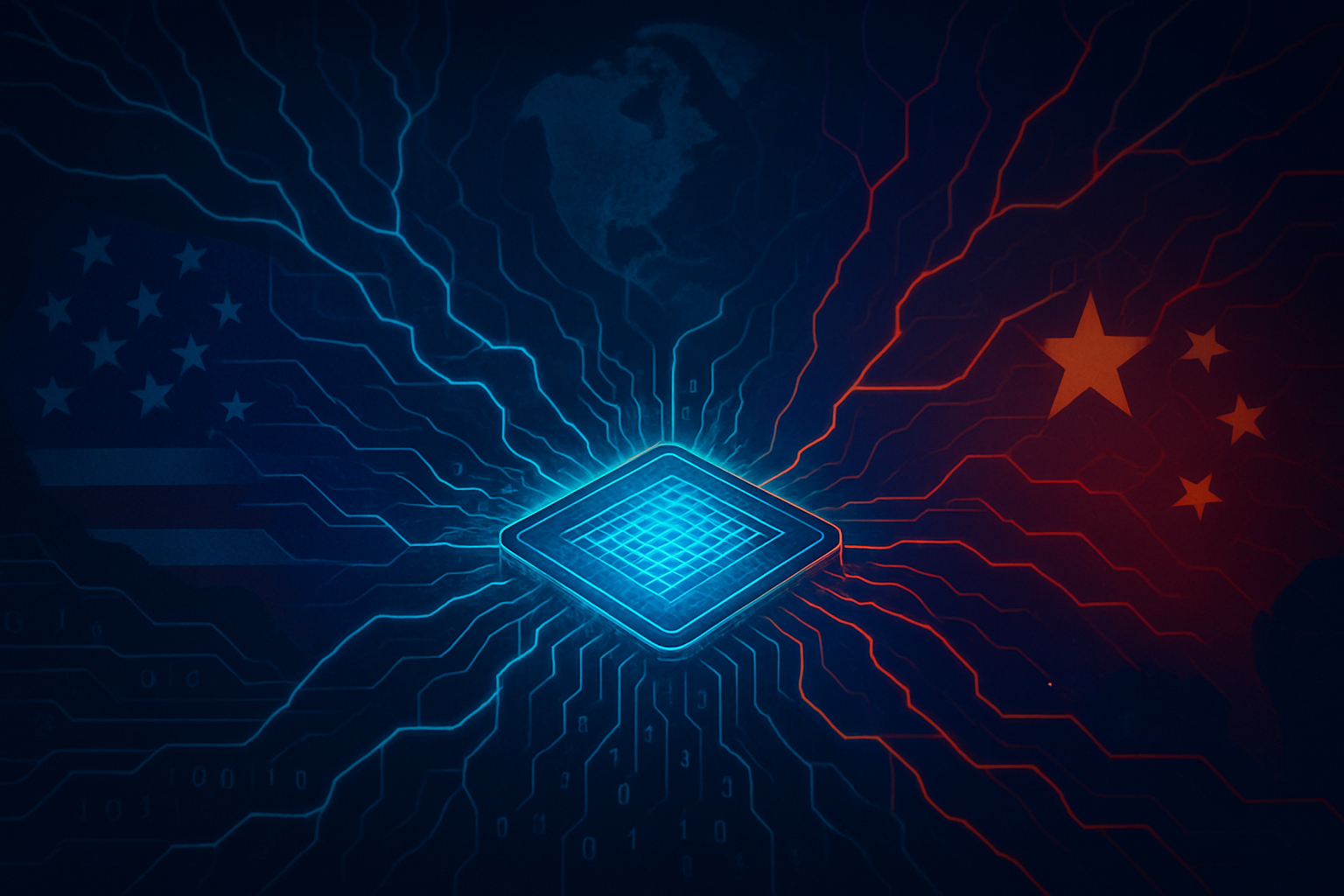Beijing's conditional lifting of export restrictions on Nexperia products offers immediate relief to a beleaguered global automotive industry, yet the underlying currents of geopolitical rivalry and supply chain vulnerabilities persist, signaling a precarious peace in the escalating tech cold war.
In a move that reverberated across global markets on November 1, 2025, China's Ministry of Commerce announced a conditional exemption for certain Nexperia semiconductor products from its recently imposed export ban. This "chip export thaw" immediately de-escalates a rapidly intensifying trade dispute, averting what threatened to be catastrophic production stoppages for car manufacturers worldwide. The decision, coming on the heels of high-level diplomatic engagements, including a summit between Chinese President Xi Jinping and U.S. President Donald Trump in South Korea, and concurrent discussions with European Union officials, underscores the intricate dance between economic interdependence and national security in the critical semiconductor sector. While the immediate crisis has been sidestepped, the episode serves as a stark reminder of the fragile nature of global supply chains and the increasing weaponization of trade policies.
The Anatomy of a De-escalation: Nexperia's Pivotal Role
The Nexperia crisis, a significant flashpoint in the broader tech rivalry, originated in late September 2025 when the Dutch government invoked a rarely used Cold War-era law, the Goods Availability Act, to effectively seize control of Nexperia, a Dutch-headquartered chipmaker. Citing "serious governance shortcomings" and national security concerns, the Netherlands aimed to safeguard critical technology and intellectual property. This dramatic intervention followed the United States' Bureau of Industry and Security (BIS) placing Nexperia's Chinese parent company, Wingtech Technology (SSE: 600745), on its entity list in December 2024, and subsequently extending export control restrictions to subsidiaries more than 50% owned by listed entities, thus bringing Nexperia under the same controls.
In swift retaliation, on October 4, 2025, China's Ministry of Commerce imposed its own export controls, prohibiting Nexperia's Chinese unit and its subcontractors from exporting specific finished components and sub-assemblies manufactured in China to foreign countries. This ban was particularly impactful because Nexperia produces basic power control chips—such as diodes, transistors, and voltage regulators—in its European wafer fabrication plants (Germany and the UK), which are then sent to China for crucial finishing, assembly, and testing. Roughly 70% of Nexperia's chips produced in the Netherlands are packaged in China, with its Guangdong facility alone accounting for approximately 80% of its final product capacity.
The recent exemption, while welcomed, is not a blanket lifting of the ban. Instead, China's Commerce Ministry stated it would "comprehensively consider the actual situation of enterprises and grant exemptions to exports that meet the criteria" on a case-by-case basis. This policy shift, a conditional easing rather than a full reversal, represents a pragmatic response from Beijing, driven by the immense economic pressure from global industries. Initial reactions from industry experts and governments, including Berlin, were cautiously optimistic, viewing it as a "positive sign" while awaiting full assessment of its implications. The crisis, however, highlighted the critical role of these "relatively simple technologies" which are foundational to a vast array of electronic designs, particularly in the automotive sector, where Nexperia supplies approximately 49% of the electronic components used in European cars.
Ripple Effects Across the Tech Ecosystem: From Giants to Startups
While Nexperia (owned by Wingtech Technology, SSE: 600745) does not produce specialized AI processors, its ubiquitous discrete and logic components are the indispensable "nervous system" supporting the broader tech ecosystem, including the foundational infrastructure for AI systems. These chips are vital for power management, signal conditioning, and interface functions in servers, edge AI devices, robotics, and the myriad sensors that feed AI algorithms. The easing of China's export ban thus carries significant implications for AI companies, tech giants, and startups alike.
For AI companies, particularly those focused on edge AI solutions and specialized hardware, a stable supply of Nexperia's essential components ensures that hardware development and deployment can proceed without bottlenecks. This predictability is crucial for maintaining the pace of innovation and product rollout, allowing smaller AI innovators, who might otherwise struggle to secure components during scarcity, to compete on a more level playing field. Access to robust, high-volume components also contributes to the power efficiency and reliability of AI-enabled devices.
Tech giants such as Apple (NASDAQ: AAPL), Samsung (KRX: 005930), Huawei (SHE: 002502), Google (NASDAQ: GOOGL), and Microsoft (NASDAQ: MSFT), with their vast and diverse product portfolios spanning smartphones, IoT devices, data centers, and burgeoning automotive ventures, are major consumers of Nexperia's products. The resumption of Nexperia exports alleviates a significant supply chain risk that could have led to widespread production halts. Uninterrupted supply is critical for mass production and meeting consumer demand, preventing an artificial competitive advantage for companies that might have stockpiled. The automotive divisions of these tech giants, deeply invested in self-driving car initiatives, particularly benefit from the stable flow of these foundational components. While the initial ban caused a scramble for alternatives, the return of Nexperia products stabilizes the overall market, though ongoing geopolitical tensions will continue to push tech giants to diversify sourcing strategies.
Startups, often operating with leaner inventories and less purchasing power, are typically most vulnerable to supply chain shocks. The ability to access Nexperia's widely used and reliable components is a significant boon, reducing the risk of project delays, cost overruns, and even failure. This stability allows them to focus precious capital on innovation, market entry, and product differentiation, rather than mitigating supply chain risks. While some startups may have pivoted to alternative components during the ban, the long-term effect of increased availability and potentially better pricing is overwhelmingly positive, fostering a more competitive and innovation-driven environment.
Geopolitical Chessboard: Trade Tensions and Supply Chain Resilience
The Nexperia exemption must be viewed through the lens of intensifying global competition and geopolitical realignments in the semiconductor industry, fundamentally shaping broader China-Europe trade relations and global supply chain trends. This incident starkly highlighted Europe's reliance on Chinese-controlled segments of the semiconductor supply chain, even for "mature node" chips, demonstrating its vulnerability to disruptions stemming from geopolitical disputes.
The crisis underscored the nuanced difference between the United States' more aggressive "decoupling" strategy and Europe's articulated "de-risking" approach, which aims to reduce critical dependencies without severing economic ties. China's conditional easing could be interpreted as an effort to exploit these differences and prevent a unified Western front. The resolution through high-level diplomatic engagement suggests a mutual recognition of the economic costs of prolonged trade disputes, with China demonstrating a desire to maintain trade stability with Europe even amidst tensions with the US. Beijing has actively sought to deepen semiconductor ties with Europe, advocating against unilateralism and for the stability of the global semiconductor supply chain.
Globally, semiconductors remain at the core of modern technology and national security, making their supply chains a critical geopolitical arena. The US, since October 2022, has implemented expansive export controls targeting China's access to advanced computing chips and manufacturing equipment. In response, China has doubled down on its "Made in China 2025" initiative, investing massively to achieve technological self-reliance, particularly in mature-node chips. The Nexperia case, much like China's earlier restrictions on gallium and germanium exports (July 2023, full ban to US in December 2024), exemplifies the weaponization of supply chains as a retaliatory measure. These incidents, alongside the COVID-19 pandemic-induced shortages, have accelerated global efforts towards diversification, friend-shoring, and boosting domestic production (e.g., the EU's goal to increase its share of global semiconductor output to 20% by 2030) to build more resilient supply chains. While the exemption offers short-term relief, the underlying geopolitical tensions, unresolved technology transfer concerns, and fragmented global governance remain significant concerns, contributing to long-term supply chain uncertainty.
The Road Ahead: Navigating a Volatile Semiconductor Future
Following China's Nexperia export exemption, the semiconductor landscape is poised for both immediate adjustments and significant long-term shifts. In the near term, the case-by-case exemption policy from China's Ministry of Commerce (MOFCOM) is expected to bring crucial relief to industries, with the automotive sector being the primary beneficiary. The White House is also anticipated to announce the resumption of shipments from Nexperia's Chinese facilities. However, the administrative timelines and specific criteria for these exemptions will be closely watched.
Long-term, this episode will undoubtedly accelerate existing trends in supply chain restructuring. Expect increased investment in regional semiconductor manufacturing hubs across North America and Europe, driven by a strategic imperative to reduce dependence on Asian supply chains. Companies will intensify efforts to diversify their supply chains through dual-sourcing agreements, vertical integration, and regional optimization, fundamentally re-evaluating the viability of highly globalized "just-in-time" manufacturing models in an era of geopolitical volatility. The temporary suspension of the US's "50% subsidiary rule" for one year also provides a window for Nexperia's Chinese parent, Wingtech Technology (SSE: 600745), to potentially mitigate the likelihood of a mandatory divestment.
While Nexperia's products are foundational rather than cutting-edge AI chips, they serve as the "indispensable nervous system" for sophisticated AI-driven systems, particularly in autonomous driving and advanced driver-assistance features in vehicles. The ongoing supply chain disruptions are also spurring innovation in technologies aimed at enhancing resilience, including the further development of "digital twin" technologies to simulate disruptions and identify vulnerabilities, and the use of AI algorithms to predict potential supply chain issues.
However, significant challenges persist. The underlying geopolitical tensions between the US, China, and Europe are far from resolved. The inherent fragility of globalized manufacturing and the risks associated with relying on single points of failure for critical components remain stark. Operational and governance issues within Nexperia, including reports of its China unit defying directives from the Dutch headquarters, highlight deep-seated complexities. Experts predict an accelerated "de-risking" and regionalization, with governments increasingly intervening through subsidies to support domestic production. The viability of globalized just-in-time manufacturing is being fundamentally questioned, potentially leading to a shift towards more robust, albeit costlier, inventory and production models.
A Precarious Peace: Assessing the Long-Term Echoes of the Nexperia Truce
China's Nexperia export exemption is a complex diplomatic maneuver that temporarily eases immediate trade tensions and averts significant economic disruption, particularly for Europe's automotive sector. It underscores a crucial takeaway: in a deeply interconnected global economy, severe economic pressure, coupled with high-level, coordinated international diplomacy, can yield results in de-escalating trade conflicts, even when rooted in fundamental geopolitical rivalries. This incident will be remembered as a moment where pragmatism, driven by the sheer economic cost of a prolonged dispute, momentarily trumped principle.
Assessing its significance in trade history, the Nexperia saga highlights the increasing weaponization of export controls as geopolitical tools. It draws parallels with China's earlier restrictions on gallium and germanium exports, and the US sanctions on Huawei (SHE: 002502), demonstrating a tit-for-tat dynamic that shapes the global technology landscape. However, unlike some previous restrictions, the immediate and widespread economic impact on multiple major economies pushed for a quicker, albeit conditional, resolution.
The long-term impact will undoubtedly center on an accelerated drive for supply chain diversification and resilience. Companies will prioritize reducing reliance on single suppliers or regions, even if it entails higher costs. Governments will continue to prioritize the security of their semiconductor supply chains, potentially leading to more interventions and efforts to localize production of critical components. The underlying tensions between economic interdependence and national security objectives will continue to define the semiconductor industry's trajectory.
In the coming weeks and months, several key aspects warrant close observation: the speed and transparency of China's exemption process, the actual resumption of Nexperia chip shipments from China, and whether Nexperia's European headquarters will resume raw material shipments to its Chinese assembly plants. Furthermore, the broader scope and implementation of any US-China trade truce, the evolving dynamics of Dutch-China relations regarding Nexperia's governance, and announcements from automakers and chip manufacturers regarding investments in alternative capacities will provide crucial insights into the long-term stability of the global semiconductor supply chain. This "precarious peace" is a testament to the intricate and often volatile interplay of technology, trade, and geopolitics.
This content is intended for informational purposes only and represents analysis of current AI developments.
TokenRing AI delivers enterprise-grade solutions for multi-agent AI workflow orchestration, AI-powered development tools, and seamless remote collaboration platforms.
For more information, visit https://www.tokenring.ai/.



